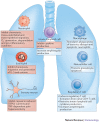Specialized pro-resolving mediators: endogenous regulators of infection and inflammation
- PMID: 26688348
- PMCID: PMC5242505
- DOI: 10.1038/nri.2015.4
Specialized pro-resolving mediators: endogenous regulators of infection and inflammation
Abstract
Specialized pro-resolving mediators (SPMs) are enzymatically derived from essential fatty acids and have important roles in orchestrating the resolution of tissue inflammation - that is, catabasis. Host responses to tissue infection elicit acute inflammation in an attempt to control invading pathogens. SPMs are lipid mediators that are part of a larger family of pro-resolving molecules, which includes proteins and gases, that together restrain inflammation and resolve the infection. These immunoresolvents are distinct from immunosuppressive molecules as they not only dampen inflammation but also promote host defence. Here, we focus primarily on SPMs and their roles in lung infection and inflammation to illustrate the potent actions these mediators play in restoring tissue homeostasis after an infection.
Conflict of interest statement
B.D.L. is a co-inventor on patents assigned to Brigham and Women's Hospital; some of these patents (those pertaining to resolvins) are licensed to Resolvyx Pharmaceuticals. The interests of B.D.L. were reviewed and are managed by the Brigham and Women's Hospital and Partners HealthCare in accordance with their conflict-of-interest policies.
Figures




References
Publication types
MeSH terms
Substances
Grants and funding
LinkOut - more resources
Full Text Sources
Other Literature Sources

